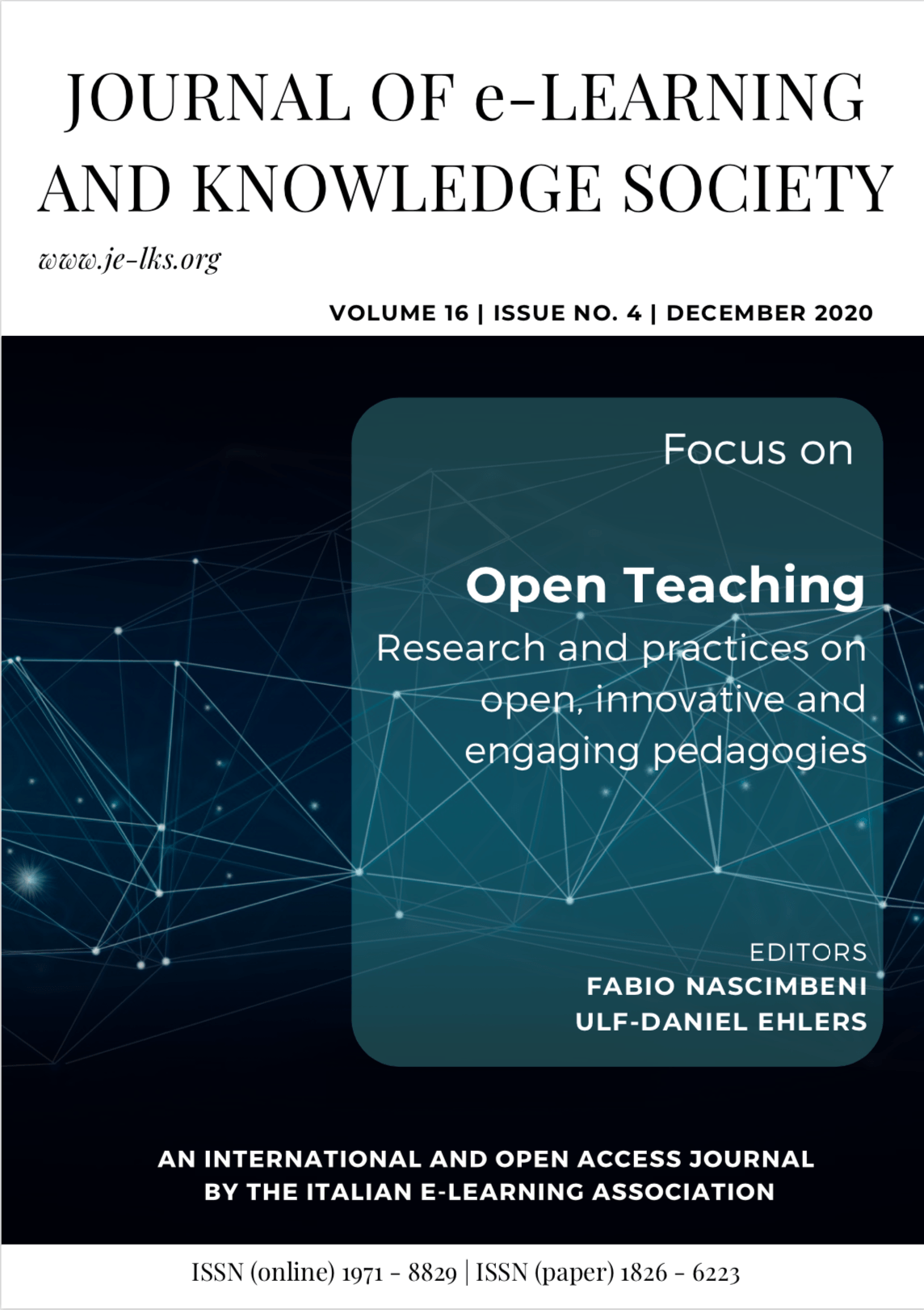Main Article Content
Abstract
This paper describes an open platform for the advanced experience of music information. Based on the IEEE 1599 standard, such an environment supports an integrated and synchronized multi-layer description of music pieces. This approach can be particularly suitable in higher music education, where the structured organization of a multiplicity of free resources can foster advanced and engaging learning activities. After addressing the subject of openness in music education and introducing the key features of the IEEE 1599 format, some clarifying examples and educational scenarios will be discussed.
Keywords
Article Details

This work is licensed under a Creative Commons Attribution-NonCommercial-ShareAlike 4.0 International License.
The author declares that the submitted to Journal of e-Learning and Knowledge Society (Je-LKS) is original and that is has neither been published previously nor is currently being considered for publication elsewhere.
The author agrees that SIe-L (Italian Society of e-Learning) has the right to publish the material sent for inclusion in the journal Je-LKS.
The author agree that articles may be published in digital format (on the Internet or on any digital support and media) and in printed format, including future re-editions, in any language and in any license including proprietary licenses, creative commons license or open access license. SIe-L may also use parts of the work to advertise and promote the publication.
The author declares s/he has all the necessary rights to authorize the editor and SIe-L to publish the work.
The author assures that the publication of the work in no way infringes the rights of third parties, nor violates any penal norms and absolves SIe-L from all damages and costs which may result from publication.
The author declares further s/he has received written permission without limits of time, territory, or language from the rights holders for the free use of all images and parts of works still covered by copyright, without any cost or expenses to SIe-L.
For all the information please check the Ethical Code of Je-LKS, available at http://www.je-lks.org/index.php/ethical-code
References
- Avanzini F., Baratè A., Ludovico L. A., Mandanici M. (2020). A Multidimensional Taxonomy of Digital Learning Materials for Music Education. In: Daniela L. (ed.) Smart Pedagogy of Digital Learning, 88–103, London, Routledge.
- Baggi D., Haus G. (2013). Music navigation with symbols and layers: Toward content browsing with IEEE 1599 XML encoding, John Wiley & Sons.
- Baker J. (2007). Smart board in the music classroom, Music Educators Journal, 93(5), 18–20.
- Baratè A., Haus G., Ludovico L. A. (2020). Learning, Teaching, and Making Music Together in the COVID-19 Era Through IEEE 1599. In: The 28th International Conference on Software, Telecommunications and Computer Networks (SoftCOM 2020), in press.
- Baratè A., Haus G., Ludovico L. A., Mauro D. A. (2012). IEEE 1599 for live musical and theatrical performances, Journal of Multimedia, 7(2), 170–178, Academy Publisher.
- Baratè A., Haus G., Ludovico L. A., Pagani E., Scarabottolo N. (2019). 5G Technology and Its Applications to Music Education. In: Multi Conference on Computer Science and Information Systems, MCCSIS 2019 - Proceedings of the International Conference on e-Learning 2019, 65–72.
- Baratè A., Ludovico L. A. (2012). New Frontiers in Music Education through the IEEE 1599 Standard. In Cordeiro J., Helfert M., Martins M. J. (eds.) Proceedings of the 4th International Conference on Computer Supported Education (CSEDU 2012), Porto, Portugal, vol. 1, 146–151, Setúbal, SCITEPRESS.
- Baratè A., Ludovico L. A. (2016). Local and global Semantic Networks for the representation of music information, Journal of E-Learning and Knowledge Society, 12(4), 109–123.
- Blessinger P., Bliss T. (2016). Open Education: International Perspectives in Higher Education, Cambridge, UK, Open Book.
- Daniela L. (2019). Smart pedagogy for technology-enhanced learning. In: Daniela L. (ed.) Didactics of smart pedagogy, 3-21, Cham, Springer.
- Dalmonte R. (2008). Analisi melodica e tecnologia: un esempio da Tosca di Puccini. In: Nuovo in musica. Estetiche, tecnologie, linguaggi. Atti del convegno, Trento, 18-20 gennaio 2008, 223-236.
- Iiyoshi T., Kumar M. S. V. (2010), Opening up education: The collective advancement of education through open technology, open content, and open knowledge, Cambridge, MA, The MIT Press.
- Jansen D., Schuwer R., Teixeira A., Aydin, C. H. (2015), Comparing MOOC adoption strategies in Europe: Results from the HOME project survey, International Review of Research in Open and Distributed Learning, 16(6), 116–136.
- Llorens F., Molina R., Compañ P., Satorre R. (2014), Technological Ecosystem for Open Education, Frontiers in Artificial Intelligence and Applications, 22, 706–715.
- Luo S., Wang Y., Xiong N., Shan P., Zhou Y. (2018). An interactive smart music toy design for children. In: International Conference on Distributed, Ambient, and Pervasive Interactions, 372–390, Springer.
- Seely Brown J., Adler R. P. (2008), Open education, the long tail, and learning 2.0, Educause review, 43(1), 16–20.
- Steels L. (2015). Music Learning with Massive Open Online Courses (MOOCs), IOS Press.
- Stracke C. M. (2017, July), The Quality of MOOCs: How to improve the design of open education and online courses for learners? In: Zaphiris P., Ioannou A. (eds) Learning and Collaboration Technologies. Novel Learning Ecosystems. LCT 2017, Lecture Notes in Computer Science, 10295, Cham, Springer. https://doi.org/10.1007/978-3-319-58509-3_23
- UNESCO - United Nations Educational, Scientific and Cultural Organization (2002), Forum on the impact of open courseware for higher education in developing countries, Final report.
- Wiley D. (2015), The MOOC misstep and the open education infrastructure. In: Bonk C. J., Lee M. M., Reeves T. C., Reynolds T. H. (eds) MOOCs and open education around the world, 3–11, London, UK, Routledge.
- Yuan L., Powell S. (2013). MOOCs and open education: Implications for higher education, Halton, UK, Cetis – Centre for Educational Technology & Interoperability Standards.

